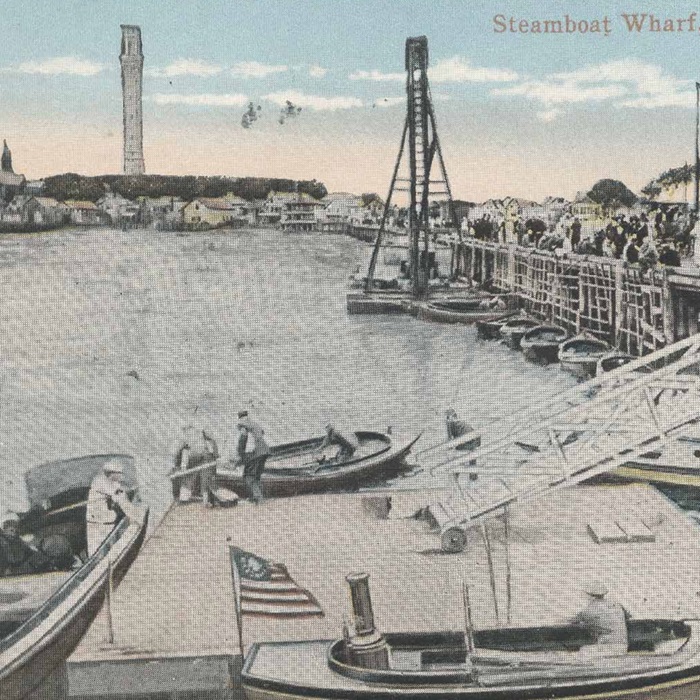From the June 24, 1920 issue of the Provincetown Advocate, selected and edited by Kaimi Rose Lum
Groton, Conn, June 19 — With water from the famous Pilgrim Spring, one of Cape Cod’s daughters wrote another line on Provincetown’s pages in history’s book today when she crashed a bottle against the bow of the U.S. Steamship Provincetown as the steamer slid down the ways at the Groton Iron Works.
There could hardly have been more brilliant a launching. A hundred of Provincetown’s sons and daughters — townsfolk and those who, now of other cities, had gathered to see their home town again honored — crowded the gaily decked launching platform and joined in cheering as the steel steamship slid proudly into the Thames. It was as pretty and perfect a launching as ever was staged.
Mrs. Cora G.W. Fuller was the Provincetown’s sponsor.
Down at the tip of Cape Cod in Massachusetts — Provincetown, whence the new ocean crosser got her name — whistles were tooting, bells on churches and schools were ringing and little groups gathered to cheer as the hour struck one.
 “She’s a boat,” said Provincetown seamen in the launching party as the new steamer rode the Thames. And the men who spoke her perfectness are men of the sea. But even to a landsman the Provincetown presented a proud picture as saucy tugs pushed at her sides to dock her.
“She’s a boat,” said Provincetown seamen in the launching party as the new steamer rode the Thames. And the men who spoke her perfectness are men of the sea. But even to a landsman the Provincetown presented a proud picture as saucy tugs pushed at her sides to dock her.
F.P. Hall, plant manager of the Groton Iron Works, opened the launching ceremonies by welcoming the guests and introducing Miss Martha Josephine Atkins, O.B., of Provincetown.
Miss Atkins, a reader of wide prominence, read her original poem, “The Launching of the Provincetown.” Miss Atkins’ voice sounded clear, even above the sound of the pounding of the hammers as the workmen slammed the final wedges beneath the stays prior to the “final cut.”
There was much applause as Miss Atkins concluded and the order was passed to cut the ship away. As the sound of the saws came up from the dock, Mrs. Fuller, to whom speaker after speaker later paid tribute … stepped forward. Above her from the bow of the Provincetown swung a rope from which dangled a dozen big American beauty roses — Mrs. Fuller’s christening gift to the Provincetown.
In her arm the sponsor held a large bouquet of crimson roses and in her right hand she grasped a bottle filled with sparkling water from the famous Pilgrim Spring at Provincetown where Indians drank and where the Pilgrims got their first drink of water in America.
A shout from the crowd, “She goes,” and Mrs. Fuller swung the bottle against the steel prow. “Go, Provincetown,” she shouted, and the water sprayed over her as it trickled down the boat. The crash of the bottle was lost in the din that arose.
As the steamer cleared the ways she floated into the waters of the river, sprinkled with blossoms from Cape Cod, wild sweet peas gathered at the tip of the arm of Massachusetts by Mrs. Rose Lowther, wife of the keeper of Race Point Light, and flung — some of them — from the Provincetown by a former Provincetown man, A.H. Adams. Mr. Adams was the workman who “framed” the ship in her building.
The Provincetown is a single screw cargo steamer of the shelter deck type with a poop and forecastle and with machinery amidships.
For handling cargo the Provincetown has two steel masts with four five-ton booms on each, and two derrick posts, each fitted with three-ton booms, all on the shelter deck. On after side of the foremast there is one 30-ton cargo boom. Accommodations for the officers are located in a steel deck house amidships and the crew is berthed in the forecastle and poop in cubicles.
Manned, she will carry a crew of 60 men. She is built to develop a speed of 10-1/2 knots and is propelled by a compound turbine of 800 S.H.P., the propeller speed being 90 revolutions per minute.



